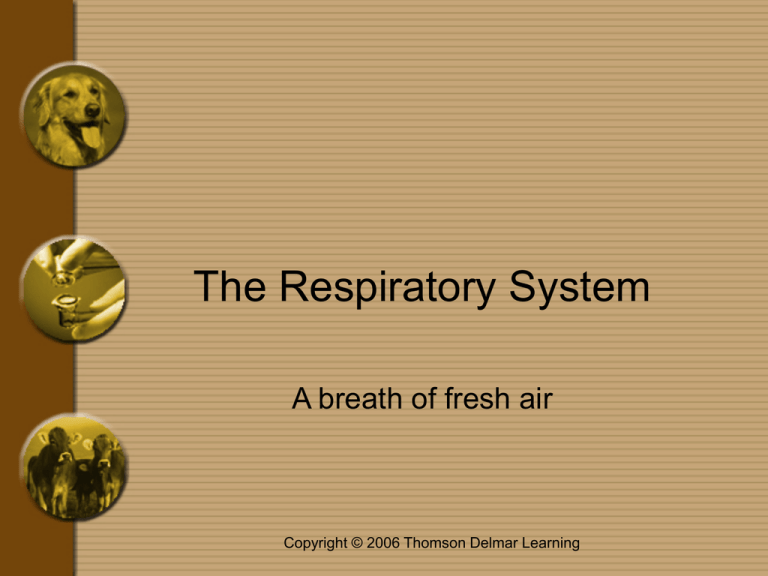Respiratory System
advertisement

The Respiratory System A breath of fresh air Copyright © 2006 Thomson Delmar Learning Functions of the Respiratory System • Capture oxygen from the air and place it in the bloodstream for distribution to the cells of the animal’s body – All cells in the body require oxygen to live – Works in conjuntion with the circulatory system to distribute oxygen throughout the body • Removes Carbon Dioxide Copyright © 2006 Thomson Delmar Learning Types of Respiratory Systems • Lungs – Oxygen is inhaled into the lungs from the air – The lungs filter out the Oxygen and passes it to the Red Blood Cells • Gills – Water molecules pass over the gills – The gills filter out the Oxygen in the water and passes it to the Red Blood Cells Copyright © 2006 Thomson Delmar Learning The Respiratory System • The respiratory system is divided into upper and lower tracts • The upper respiratory tract consists of the nose, mouth, pharynx, epiglottis, and larynx • The lower respiratory tract consists of the trachea, bronchial tree, and lungs Copyright © 2006 Thomson Delmar Learning The Respiratory Tract Copyright © 2006 Thomson Delmar Learning Upper Respiratory Tract • Air enters and exits the body through the nose – nas/o and rhin/o are combining forms for nose – External openings of the nose area are called nares Copyright © 2006 Thomson Delmar Learning Upper Respiratory Tract • The pharynx is the area from the back of the nasal cavity and mouth to the larynx – pharyng/o is the combining form for pharynx – Commonly called the throat Copyright © 2006 Thomson Delmar Learning Nasal cavity Pharynx Esophagus Mouth Larynx Epiglottis Tongue Trachea Copyright © 2006 Thomson Delmar Learning Upper Respiratory Tract • The larynx is the area between the pharynx and the trachea – Commonly called the voice box • contains the vocal cords • Prevents food from entering the Lungs Copyright © 2006 Thomson Delmar Learning Upper Respiratory Tract • Trachea – Large air-tube that leads to the lungs • Epiglottis – The gate for food and water to travel down the Esophagus, and air into the Trachea Copyright © 2006 Thomson Delmar Learning Lower Respiratory Tract • The trachea extends from the neck to the chest and passes air from the larynx to the thoracic cavity – trache/o is the combining form for the trachea – Commonly called the windpipe • contains C-shaped cartilaginous rings Copyright © 2006 Thomson Delmar Learning Lower Respiratory Tract • The trachea divides into two branches at the tracheal bifurcation to form bronchi – bronch/o is the combining form for bronchi – Bronchus is the singular form of bronchi Copyright © 2006 Thomson Delmar Learning Lower Respiratory Tract • The bronchi continue to get smaller in diameter until they become bronchioles, The location where the Trachea branches to the two lungs – bronchiol/o is the combining form for bronchioles – -ole means small Copyright © 2006 Thomson Delmar Learning Lower Respiratory Tract • Alveoli are air sacs where gas exchange occurs, Surrounded by blood vessels; carbon dioxide is removed from blood and oxygen is absorbed into the blood – alveol/o is the combining form for alveoli (small sac) – Oxygen diffuses and carbon dioxide diffuses across the Copyright © 2006 Thomson Delmar Learning alveolar wall Supporting Structures • The thoracic cavity is contained within the ribs – cost/o is the combining form for ribs – thorac/o and -thorax both mean chest cavity or chest Copyright © 2006 Thomson Delmar Learning Supporting Structures • The lung is the main organ of respiration – The lungs are divided into well-defined divisions called lobes – pneum/o, pneumon/o, and pneu all mean lungs or air – pulm/o and plumon/o mean lung Copyright © 2006 Thomson Delmar Learning Supporting Structures • The lung is encased in a membranous sac called the pleura – The pleura has two layers, and between these two layers is the pleural space – pleur/o is the combining form for pleura Copyright © 2006 Thomson Delmar Learning Supporting Structures • The diaphragm is the muscle that separates the thoracic and peritoneal cavities – dia- means across – phragm/o is the combining form for wall – diaphragmat/o and phren/o are combining forms for diaphragm Copyright © 2006 Thomson Delmar Learning Supporting Structures • Breathing is the inhalation and exhalation of air – Inhalation is the drawing in of a breath – Exhalation is the release of a breath • Respiration is the exchange of oxygen and carbon dioxide Copyright © 2006 Thomson Delmar Learning Terms Associated with Breathing • The root pnea means breathing • ox/i, ox/o, and ox/y refer to oxygen • capn/o refers to carbon dioxide • • • • • • • • • apnea dyspnea bradypnea tachypnea hyperpnea hypopnea hypoxia hypercapnia hypocapnia Copyright © 2006 Thomson Delmar Learning







